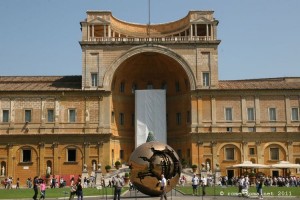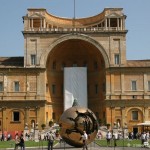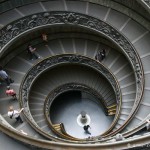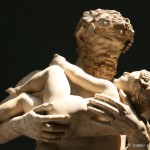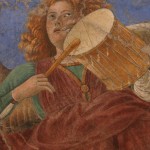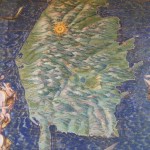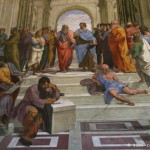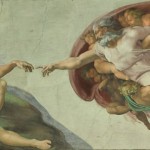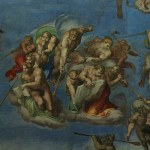In Italian: Musei Vaticani
The Vatican Museums form the largest and most visited museum complex in Italy. It’s easy to get lost there, so it’s best to pre-select the objects and places you want to see.
The visit to the Vatican Museums, including the Sistine Chapel, ranks number 4 on our Top 30 in Rome.
Overview of the Vatican Museums: A Unique Collection
The 12 Vatican Museums are housed within the Palaces of the Popes, built during the Renaissance, across 1,400 rooms and a 7-kilometer route. This makes it one of the world’s largest art collections, amassed over time through Vatican acquisitions. These collections include numerous masterpieces, such as sculptures, frescoes, mosaics, and objects spanning from ancient Egyptian times to the modern era, including medieval and Renaissance art and paintings.
Moreover, the palaces themselves are a compelling reason to visit, particularly to explore the famous Sistine Chapel, the Raphael Rooms, the spiral Bramante Staircase, or the Borgia Apartments adorned with Pinturicchio’s frescoes. Also worth mentioning are the Pauline Chapel and the galleries: the Lapidary Gallery in the Chiaramonti Museum, the Gallery of Candelabras, the Tapestry Gallery, and the Gallery of Geographical Maps.
The various museums within the complex:
- Pinacoteca: Paintings from the Middle Ages to the modern era, including works by Da Vinci, Caravaggio, Titian, Veronese, etc.
- Pio-Clementino Museum, featuring famous ancient sculptures and the Raphael Rooms
- Chiaramonti Museum, housing nearly a thousand pieces, mainly statues and busts of emperors
- Gregorian Egyptian Museum: Egyptian and Assyrian art
- Gregorian Etruscan Museum
- Gregorian Profane Museum: Art from ancient Rome, including mosaics from the Baths of Caracalla
- Pio-Christian Museum, featuring medieval and early Christian art
- Collection of Modern Religious Art
- Missionary Ethnological Museum, with objects from non-Christian religions such as Taoism, Buddhism, Hinduism, and animism
- Museum of the Vatican Apostolic Library, preserving the Pontifical Archives, including the Vatican Secret Archives
- Carriage Museum, showcasing carriages, saddles, automobiles, and sedan chairs
- Philatelic and Numismatic Museum, opened in 2007, featuring stamps and coins from Vatican City from 1929 to the present, plus a vast philatelic collection from the former Papal States
What to See in the Vatican Museums?
The “must-sees” include:
- The Sistine Chapel: Michelangelo’s frescoes, such as The Last Judgment and The Genesis
- The Raphael’s Rooms: The fresco The School of Athens
- The Apollo Belvedere and Laocoön statues in the Pio-Clementino Museum
- Masterpieces in the Pinacoteca: Works by Caravaggio, Leonardo da Vinci, etc.
- The Galleries of Maps and Tapestries
Then, you can add to your visit:
- Bramante Staircase: A Renaissance architectural marvel
- Borgia Apartments: Renowned for Pinturicchio’s frescoes
- Pauline Chapel: Featuring Michelangelo’s frescoes
- Collection of Modern and Contemporary Art, including Van Gogh’s unexpected *Pietà*
- Egyptian Museum
- Gallery of Candelabras
Overview of the Sistine Chapel and Michelangelo’s Frescoes
The Sistine Chapel is the main chapel of the Vatican Palaces, covered with stunning frescoes by the greatest artists of the 15th and 16th centuries. It can be accessed directly from the Scala Regia adjacent to St. Peter’s Basilica. Michelangelo created the monumental fresco The Last Judgment on the altar wall and scenes from the Old Testament on the ceiling.
The 12 paintings on the chapel’s side walls, by artists such as Perugino, Botticelli, and Ghirlandaio, depict episodes from the lives of Christ and Moses.
☞ See the page on the Sistine Chapel.
The Raphael’s Rooms: Renaissance Masterpieces
The Raphael Rooms were part of Pope Julius II’s apartments. He commissioned Raphael to decorate four rooms in the early 16th century. They represent moral and philosophical themes. The Room of the Fire in the Borgo recalls the fire of Troy, the Room of the Signature features The School of Athens and The Disputation of the Sacrament with Church figures, and the fresco of the Cardinal and Theological Virtues.
Borgia Apartments: Pinturicchio’s Frescoes
The Borgia Apartments, from the late 15th century, consist of six rooms, now housing part of the Vatican’s Museum of Modern Religious Art. They were designed as the private residence of Pope Alexander VI Borgia and his family. They stand out for their decorations, featuring a remarkable series of Renaissance frescoes painted by Bernardino Pinturicchio and his workshop between 1492 and 1494.
Practical Information and Tickets for the Vatican Museums
Official Hours and Prices
The Museums are generally open daily from 9 AM to 6 PM. Entry closes at 4 PM.
Closures: Sundays, and in 2025, January 1 and 6, February 11, March 19, April 21, May 1, June 29, August 15 and 16, November 1, December 8, 25, and 26.
2025 Prices: Full price €20 / Reduced €8 / Schoolchildren €4
Online Tickets and Guided Tours
Resources for Further Exploration
- Official website: www.museivaticani.va
- On Rome-Roma: Vatican Museums, visit, photos, and history, including the Sistine Chapel and the Raphael Rooms
- Wikipedia pages: Vatican Museums, Sistine Chapel, Vatican Palace
Photo Gallery of the Vatican Museums
- Court of the Pigna, Vatican Museums
- spiral staircase
- Chiaramonti Museum – Antiquities
- Pio Clementino Museum – Antiquities
- Pinacoteca
- Pinacoteca
- Chart Room – Vatican Museums
- Rooms of Raphael
- Sistine Chapel
- Sistine Chapel
How to Reach the Vatican Museums and Map
The museums are near St. Peter’s Square, a 10-minute walk away. There are several ways to get there, including Metro Line A, with the nearest station, Ottaviano, just a few minutes’ walk away. Many buses also stop nearby.
On foot, Castel Sant’Angelo is 20 minutes away, Piazza Navona 30 minutes, and Piazza del Popolo 30 minutes.
If you see this after your page is loaded completely, leafletJS files are missing.
Suggested Guided Tours of the Vatican
Suggested guided tours of the museums and the Sistine Chapel
FAQ and Tips for Visiting the Vatican Museums
What’s the Best Time to Visit the Museums?
To avoid crowds, it’s recommended to visit early in the morning on weekdays. Also, avoid the last Sunday of each month when entry is free (9 AM to 2 PM, last entry at 12:30 PM), unless you want to take advantage of the free admission.
How Long Does It Take to Visit the Vatican Museums?
The visit duration varies greatly. You could spend 2 to 3 hours or an entire week. It’s hard to see the highlights in less than 2 hours. Generally, a good half-day (4 to 6 hours) allows you to cover a significant portion, including sections like the Pinacoteca or the Pio-Clementino Museum.
Are Guided Tours Available, and Are They Worth It?
Yes, guided tours are offered. They provide insightful historical and artistic commentary and make navigating the vast complex easier.
The Vatican Museums offer their own guided tours, but you can also find options tailored to your preferences on GetYourGuide, for example.
Can You Buy Tickets On-Site?
Yes, but you may face long queues. See the Practical Information section for online purchases, including on www.museivaticani.va (original link kept as English version unconfirmed).
Is There a Cloakroom for Luggage?
Yes
Can You Eat in the Vatican Museums?
Yes, there are several cafés and a self-service restaurant (offering pasta, pizza, salads) with a terrace overlooking the gardens at reasonable prices. The Caffetteria Centrale offers snacks and drinks, and there’s also the Bistrot La Pigna in the courtyard, plus the Caffetteria Le Carrozze and Sixtina.







